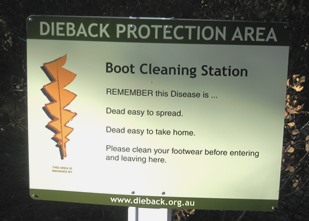
Phytophthora Dieback is a deadly introduced plant disease that devastates our forests, woodlands and heathlands. The disease is caused by the fungal pathogen Phytophthora cinnamomi. It is causing substantial damage in the southwest of WA because:
- Over 40% (~2300) of native plant species in the region are susceptible including banksias, dryandras, balgas, zamia palms, snottygobbles, sheoaks, hakeas, heaths and jarrah;
- Some native animals that rely on plant nectar for food such as honey possums and honeyeaters are also indirectly affected;
- The climate and soils of the southwest region suit its survival and spread; and
- It was spread widely before it was identified as the cause of permanent damage to our ecosystems.
The Phytophthora fungus thrives in warm, moist conditions and spends its entire life in the soil and in plant tissue. It attacks the roots of plants and causes them to rot. This kills the plant by limiting or stopping the uptake of water and nutrients. The pathogen is able to survive within plant roots during dry soil conditions commonly experienced during the summer months.
As bushwalkers we can take steps to ensure we don't contribute to the spread of the pathogen. We can minimise the risk of spreading the dieback pathogen in dieback-affected areas by:
- Keeping to well-drained, well-formed roads and tracks where possible.
- Cleaning boots and tent pegs before and after all walks and making full use of dieback wash down points and raised boardwalks where available e.g., Fitzgerald River National Park.
- Taking heed of signs alerting of the presence of dieback fungi.
- Leaders contacting the local Park Ranger for up-to-date local knowledge and redirect the walk to keep out of, or go around, dieback infected areas.
- Ensuring that drivers of vehicles taken onto roads with restricted access due to the risk of dieback are in possession of a current vehicle access permit and that all restrictions that may be imposed are adhered to.
The Club encourages members as best practice to carry a "Bushwalking Hygience Kit" in their packs and/or vehicle to help keep their footwear clean.
This kit should contain a bag to collect scraped off soil/mud, large and small brushes and a bottle of water (from mains supply). Methylated spirits 70% and water 30% can be applied to the ‘cleaned boots’ using a small spray bottle to sterilise the soles of shoes.